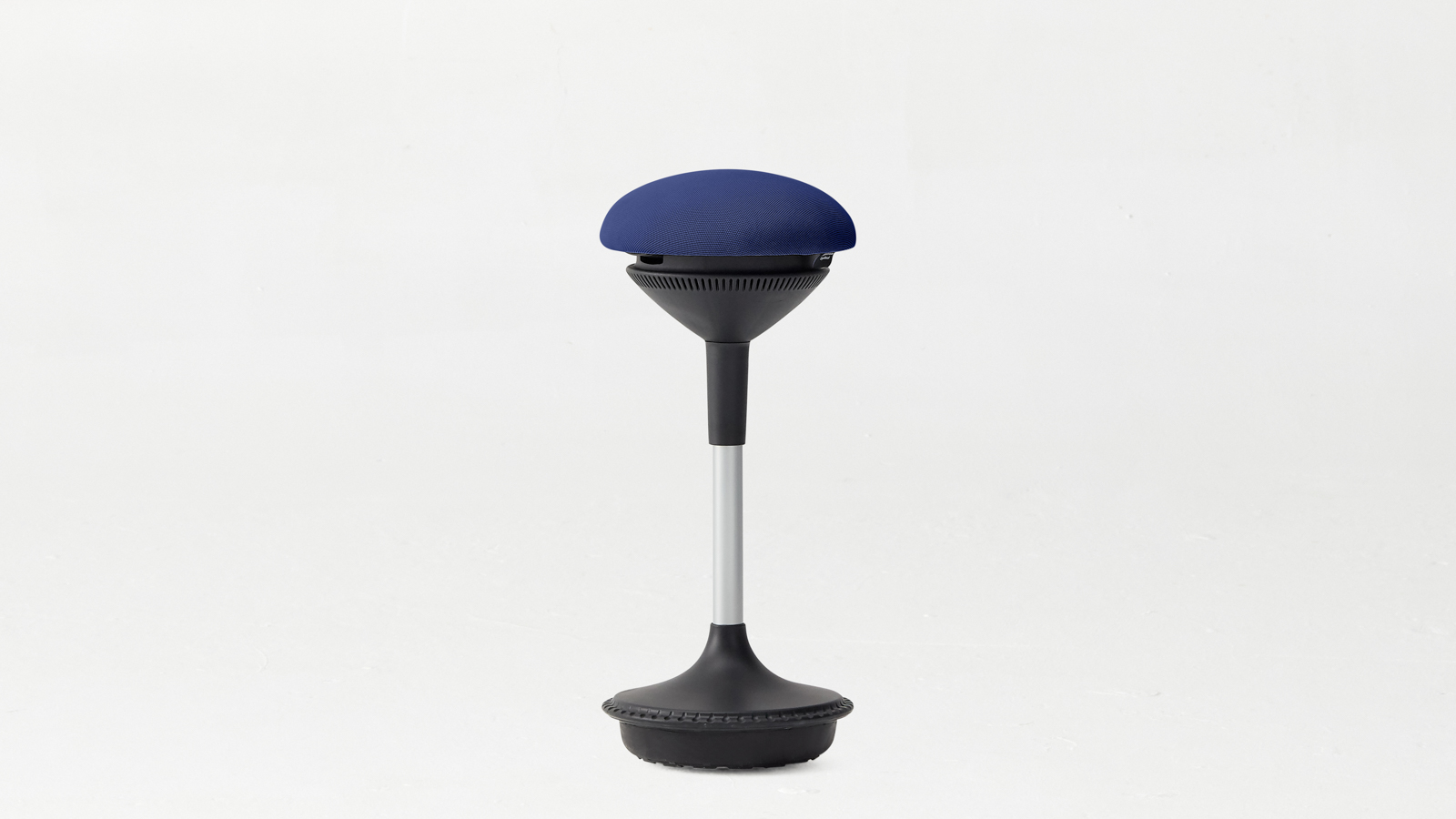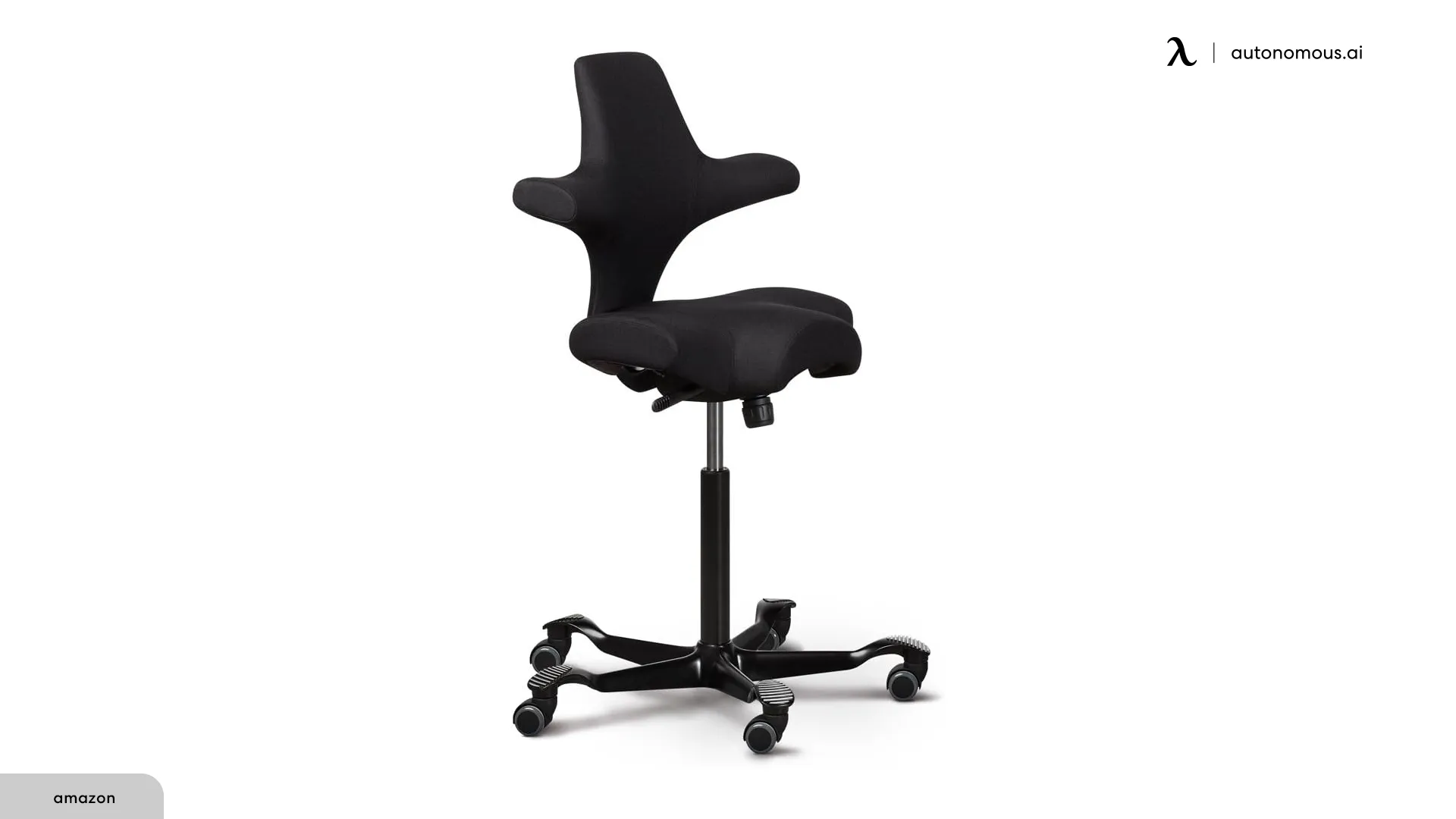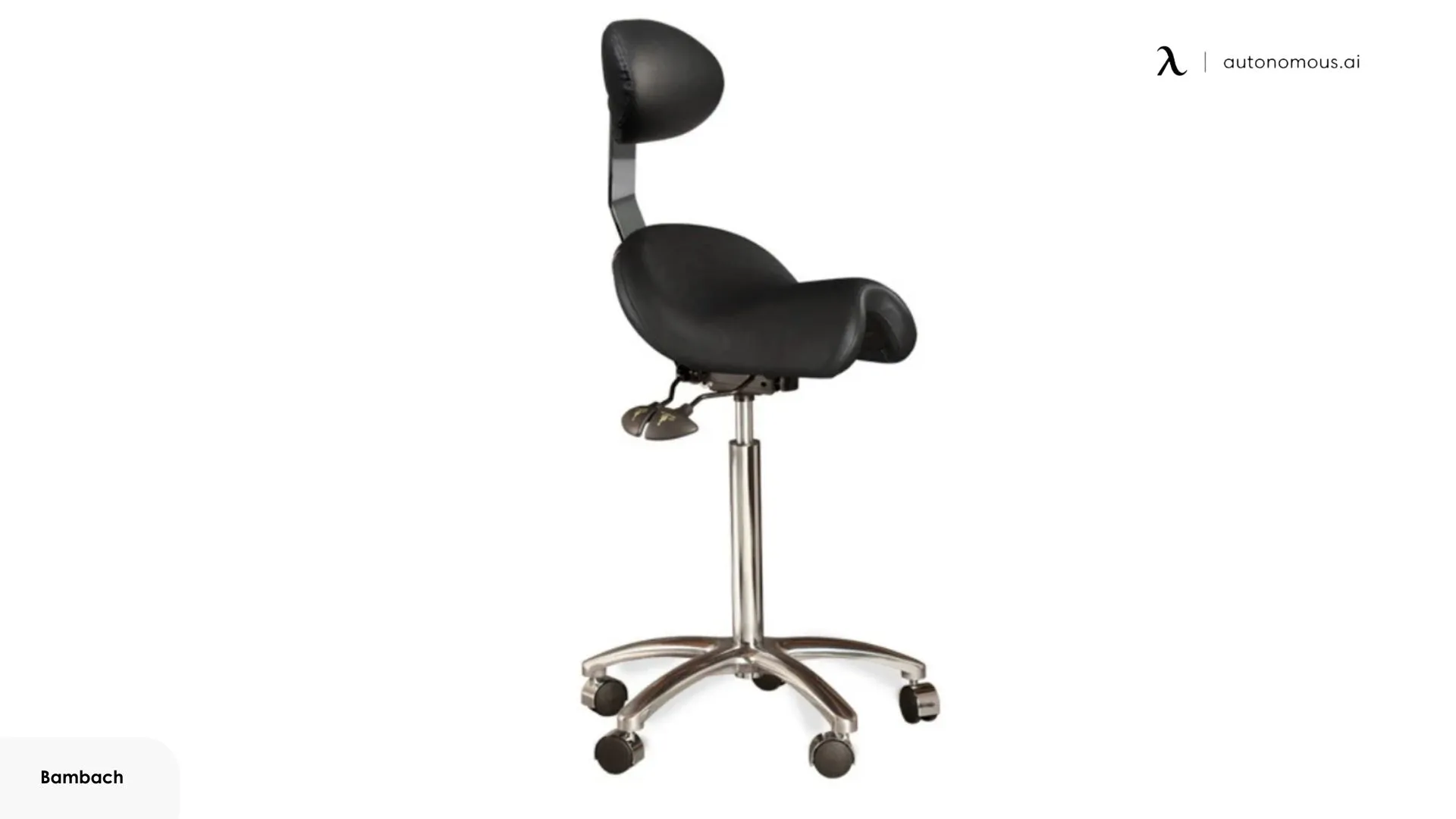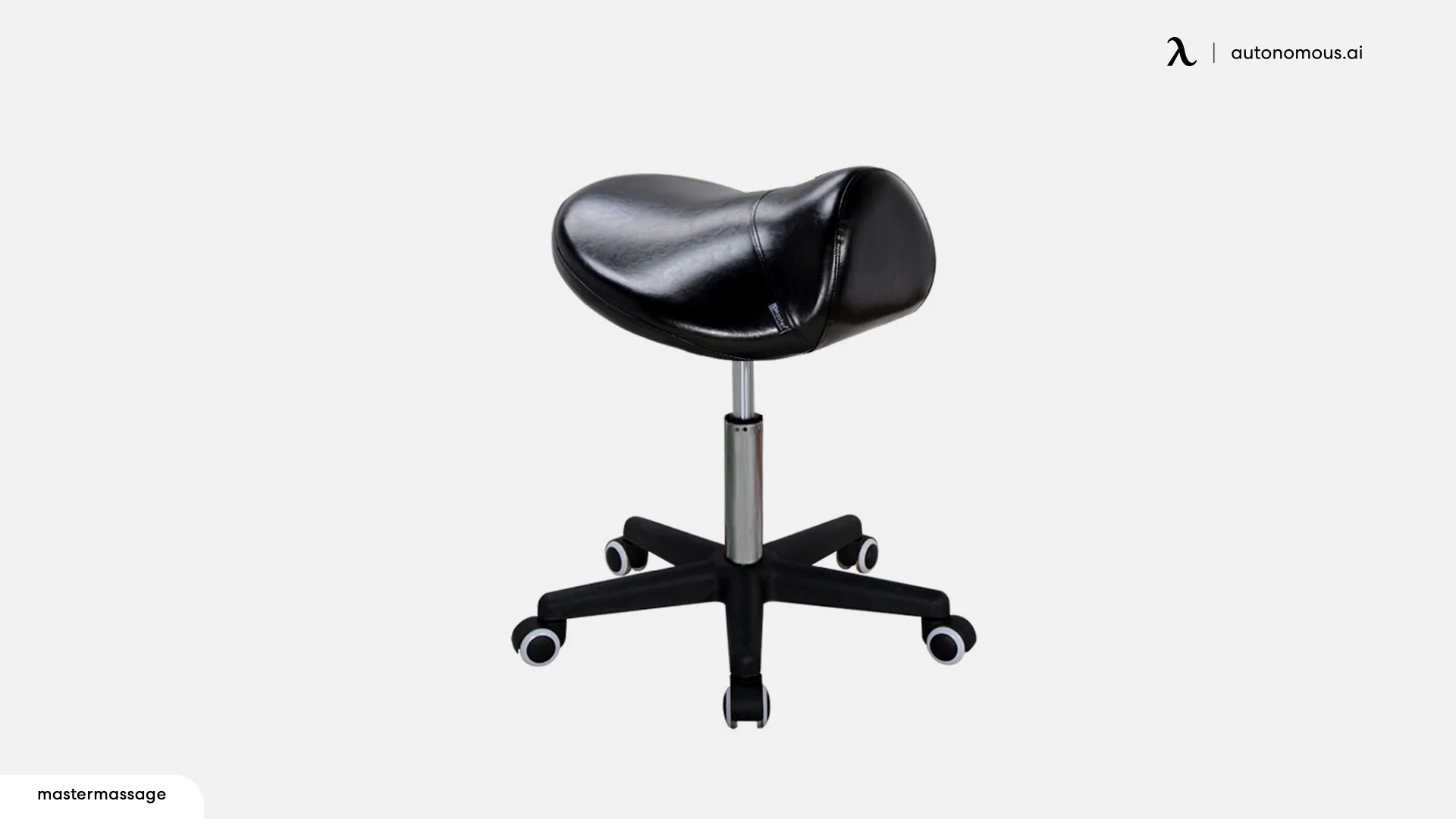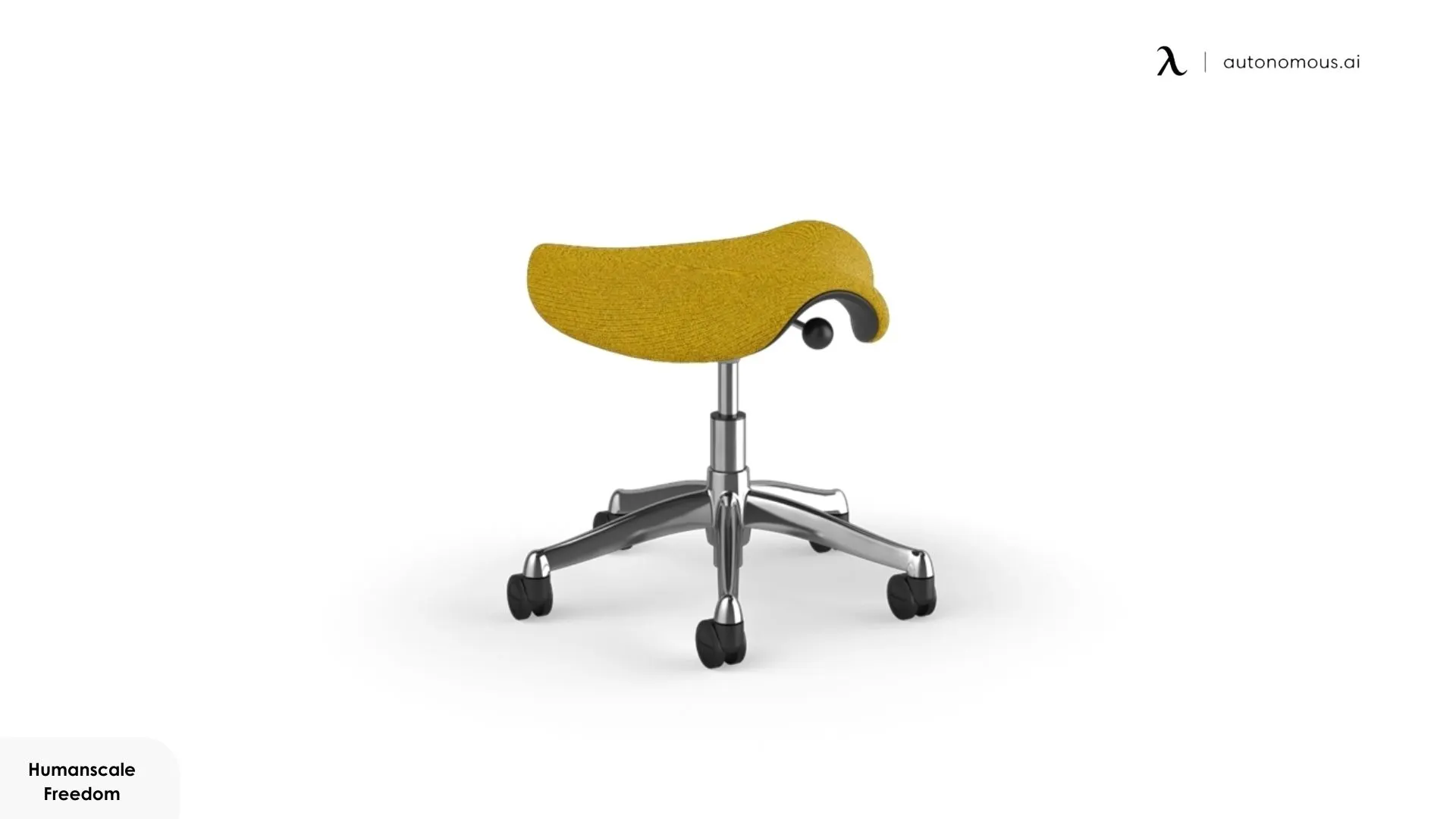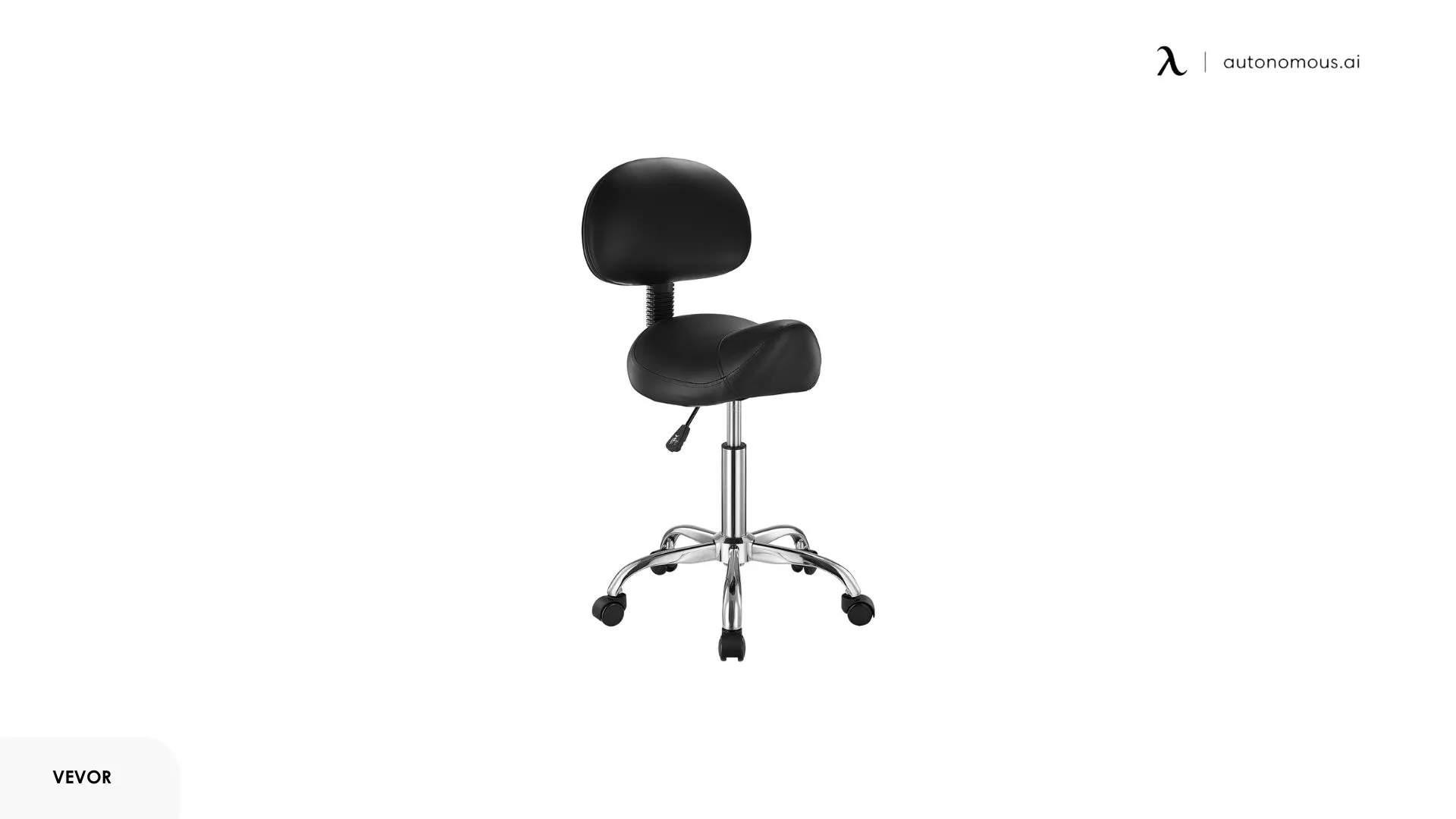
10 Best Ergonomic Saddle Chairs to Consider in 2025
Table of Contents
- 10 Best Ergonomic Saddle Chairs & Stools for Better Posture
- 1. Autonomous ErgoStool
- 2. Sit Healthier Saddle Style Split Seat Ergonomic Saddle Chair
- 3. ErgoLab Advanced Saddle
- 4. Branch Ergonomic Saddle Chair
- 5. HÅG Capisco 8106
- 6. Bambach Saddle Chair with Backrest
- 7. Master Massage Ergonomic Swivel Saddle Stool
- 8. Humanscale Freedom Saddle Stool
- 9. VEVOR Saddle Stool with Back Support and Wheels
- 10. McDooFly Saddle Stool Chair with Backrest and Footrest
- How to Adjust Your Ergonomic Saddle Office Chair for Maximum Comfort?
- FAQs
- Wrap Up
An ergonomic saddle chair isn't just another seating trend — it's a practical solution for anyone who spends long hours at a desk. Originally popular in dental and medical settings, saddle chairs and stools have found their way into home office setups, studios, and creative workspaces.
Whether you need back support or prefer a minimal ergonomic saddle stool, finding the right fit matters. In this guide, we compare the best options across both categories to help you make an informed choice.
10 Best Ergonomic Saddle Chairs & Stools for Better Posture
Not every ergonomic saddle chair works for every situation. A dental hygienist needs something different from a home office worker, and someone dealing with chronic back pain has different priorities than a musician looking for mobility in the studio.
The options below range from budget-friendly stools to premium seating designed for all-day use. We've included both solid and split-seat designs, with and without backrests, so you can find what actually fits the way you work.
- Side-by-Side Comparison:
Product | Best For | Height Range | Weight Capacity |
Autonomous ErgoStool | Adding posture variety as a secondary ergonomic saddle stool | 25" – 35" | 270 lbs |
Sit Healthier Split Seat Saddle Chair | Reducing numbness and pressure discomfort in long desk sessions | 20.5" – 27.5" | 550 lbs |
ErgoLab Advanced Saddle | Sustained sitting with durable support and tailbone pressure relief | Multiple options | 300 lbs |
Branch Saddle Chair | Compact, design-forward perch seating with premium materials | 21" – 31" | 265 lbs |
HÅG Capisco 8106 | Frequent posture changes with full ergonomic saddle chair adjustability | 16.5" – 32.0" (lift dependent) | 300 lbs |
Bambach Saddle Chair with ErgoBack | Guided upright support for long, precision-focused seated work | 18.5" – 30.0" (stem dependent) | 160 kg / ~353 lbs |
Master Massage Swivel Saddle Stool | Entry-level saddle seating for mixed-use tasks and mobility | 20.5" – 27.5" | 550 lbs |
Humanscale Freedom Saddle Stool | Standing desk perching and small spaces with lightweight mobility | 17.3" – 22.1" | 300 lbs |
VEVOR Saddle Stool with Back Support and Wheels | Budget rolling saddle stool with back support | 21.7" – 28.0" | 450 lbs |
McDooFly Saddle Stool Chair with Backrest and Footrest | Higher desks/counters (footrest support) | 21.5" – 29.5" | 400 lbs |
1. Autonomous ErgoStool
Features:
- Seat Type: Saddle-inspired contoured seat (active perch)
- Adjustments: Height adjustment (primary)
- Format: Stool-style
- Base: 5-star base (casters on most versions)
The Autonomous ErgoStool isn't a traditional saddle chair — it's closer to a supportive perch. The saddle-inspired seat keeps you from sinking into a deep slouch, while the curved base allows subtle movement as you shift weight throughout the day. Think of it as a way to stay more active at your desk without committing to a full ergonomic saddle chair.
What makes it practical is the simplicity. Height adjustment is the main control, and that's intentional — fewer settings mean less fiddling and a quicker setup. The five-star caster base rolls easily between tasks, and the compact frame slides under most desks when you're done.
Without a backrest or tilt adjustment, it works best in shorter stretches or as a secondary seat you rotate into when your main office chair starts to feel stale. Users who try to sit on it for hours without breaks tend to fatigue faster.
Best for: Users who want an ergonomic saddle stool to add posture variety at a desk, especially when their main chair encourages slouching
2. Sit Healthier Saddle Style Split Seat Ergonomic Saddle Chair
Features:
- Seat Type: Split saddle
- Height Range: 18" – 26" (varies by cylinder)
- Weight Capacity: 250 lbs
- Materials: PU leather, steel frame
- Tilt: Forward tilt standard
- Format: Chair-style
The defining feature here is the split seat. Unlike solid saddle designs, the Sit Healthier divides the cushion down the middle, which reduces contact pressure on soft tissue and improves airflow. For users who've felt numbness or discomfort after prolonged sitting in a standard chair, this design addresses the problem directly.
The forward-angled seat encourages your pelvis to tilt naturally, which helps your spine settle into a more neutral position without constant self-correction. It's the kind of passive guidance that works well for desk-bound tasks — your body finds alignment, and you don't have to think about it.
A few practical notes: the seat gap width is fixed, so fit will vary depending on your build. There's also an adjustment period. Most users need two to four weeks before the sitting position feels natural, as hip and core muscles adapt to the new posture. If you're coming from a heavily cushioned office chair, expect the transition to feel firm at first.
Best for: Office workers who experience numbness or pressure discomfort during long sessions
3. ErgoLab Advanced Saddle
Features:
- Seat Type: Solid with central groove
- Base: Powder-coated aluminum
- Foam Options: Standard, memory foam, or serene gel
- Format: Chair-style
Where some saddle chairs focus on movement or perching, the ErgoLab Advanced Saddle is built for sustained sitting. The seat features a central groove that relieves tailbone pressure, and the multi-angle pelvic positioning system helps maintain your spine's natural curve across longer work blocks. It's less about active repositioning and more about staying comfortable in one posture for extended periods.
The construction details matter here. The foam is injection-molded rather than layered, which tends to hold its shape better over years of daily use. If you prefer a softer or firmer feel, ErgoLab offers upgrades to memory foam or serene gel — a level of customization you don't often see at this price tier. The aluminum base adds stability without making the chair feel heavy or awkward to move.
Best for: Professionals who sit for long stretches and want a chair that holds up over time
4. Branch Ergonomic Saddle Chair
Features:
- Seat Type: Contoured solid saddle
- Height Range: 21"–31"
- Weight Capacity: 265 lbs
- Materials: Birch plywood frame, recycled polyester seat fabric, powder-coated aluminum base
- Format: Chair-style (perch-style use)
- Tilt: Fixed seat angle
The Branch Saddle Chair is a minimalist ergonomic saddle chair that’s built around one job: giving you a supportive perch for focused work without the bulk of a traditional task chair.
Functionally, it sits somewhere between a stool and a chair. The contoured seat encourages a natural leg position, and the height range (21"–31") works well for both standard desks and standing desk setups. The compact footprint makes it easy to tuck away or roll between workstations. The simplicity cuts both ways. If you like to fine-tune your seating position, you won't find much to adjust here. And without back support, it's better suited for shorter focused blocks than all-day sessions.
Best for: Design-conscious buyers who want a compact perch with premium materials
5. HÅG Capisco 8106
Features:
- Seat Type: Saddle-style seat (office-chair format)
- Adjustments: Seat height, seat depth, seat tilt, backrest height and tilt
- Backrest: Yes (full back support)
- Format: Chair-style
- Base: 5-star base with casters
Most saddle seats strip things down. The HÅG Capisco does the opposite, it takes the saddle concept and builds a fully adjustable office chair around it. You get seat height, seat depth, seat tilt, backrest height, and backrest tilt. The result is an ergonomic posture saddle chair that supports multiple sitting positions: upright work, forward-leaning focus, and higher perching.
The saddle shape is subtle compared to clinical-style stools, but it still encourages a wider leg stance and discourages slouching. The backrest wraps slightly around the sides, which some users find helpful for lateral support during task switching. The learning curve is real. Finding the right combination of settings takes experimentation, and users who just want to sit down and work may find it fussy at first. The price point is also higher than most options on this list — it makes the most sense if you'll actually use the adjustability rather than set it once and forget it.
Best for: Users who change postures frequently and want full chair adjustability
6. Bambach Saddle Chair with Backrest
Features:
- Seat Type: Contoured saddle seat
- Adjustments: Seat height, seat tilt (varies by configuration), backrest position
- Backrest: Yes
- Format: Chair-style
- Base: 5-star base
The Bambach approaches saddle seating differently. Where many designs treat the backrest as optional or secondary, here it's central to how the chair works. The contoured seat positions your hips in an open angle, and the backrest is designed to keep you upright without requiring constant core engagement. It's less about active sitting and more about guided alignment.
This makes it appealing for users who spend long hours seated and want postural consistency. Healthcare workers, drafters, and anyone doing precision work often prefer this kind of steady support over the freedom of a backless perch. The seat contour is more pronounced than average, which helps hold your position but may feel restrictive if you like to shift around frequently.
If you prefer wide, cushioned seats or want to recline occasionally, the Bambach won't accommodate that. It's a focused ergonomic saddle desk chair, designed for one thing and engineered to do it well.
Best for: People who want a sustained upright support without relying on core strength alone
7. Master Massage Ergonomic Swivel Saddle Stool
Features:
- Seat Size: 18"L x 16"W
- Height Range: 20.5" – 27.5"
- Weight Capacity: 550 lbs
- Format: Stool-style
- Materials: Small Cell foam, PU upholstery, nylon base
If you've seen a saddle stool in a dentist's office or physical therapy clinic, it probably looked something like this. The Master Massage Ergonomic Swivel Saddle Stool has been a staple in medical and salon settings for years, but it works equally well in a home office or creative workspace.
What stands out at this price point is the build quality. The foam is molded directly onto the seat base rather than glued, which prevents separation and extends the lifespan. The 550 lb weight capacity is unusually high for this category, and the soft polyurethane wheels roll smoothly across hardwood, tile, or carpet without leaving marks.
The seat is firm, which is intentional. For work that involves forward leaning posture, shifting between tasks, or moving around a room, that firmness keeps you balanced and engaged. It's not the right fit for eight-hour sitting marathons — there's no backrest, and the cushion doesn't have much give. But as an ergonomic saddle stool for mixed-use environments, it punches above its weight.
Best for: Budget-conscious buyers and those new to saddle seating
8. Humanscale Freedom Saddle Stool
Features:
- Seat Size: 15.5"W x 14.5"D
- Height Range: 24.25" – 32"
- Weight Capacity: 250 lbs
- Materials: High-density foam, leather/simulated leather/Ultrafabric options
- Tilt: Free-float with lock
This ergonomic saddle office chair takes a different approach from traditional ergonomic saddle stools. Its triangular cushion is contoured rather than flat, which encourages a posture that lowers the thighs and opens the hips. This design supports the lumbar spine's natural curve and reduces pressure points around the tailbone.
At 14 lbs, it's noticeably lighter than most options in this category, making it easy to move between workstations or tuck under a standing desk when not in use. The compact footprint also suits the small office desk setup or studios where a bulky chair would get in the way. It pairs well with a sit-stand routine where you alternate positions throughout the day, but it's not designed for extended seated sessions. Users who need to stay in one place for hours may find it limiting.
Best for: Standing desk users, creative studios, and environmentally conscious buyers
9. VEVOR Saddle Stool with Back Support and Wheels
Features:
- Seat Type: Solid saddle seat
- Adjustments: Height adjustment (primary); backrest position may vary by model
- Format: Stool-style
- Base: 5-star wheeled base
The VEVOR is a no-frills ergonomic saddle stool with backrest — functional, affordable, and built for jobs that keep you moving. The saddle seat provides a basic open-hip position, and the backrest offers light support for moments when you want to lean back without fully disengaging.
This isn't a chair designed for all-day desk work. The backrest is there for occasional contact, not full lumbar support, and the adjustment options are limited to seat height. What it does well is roll. The five-star wheeled base moves easily across most surfaces, which makes it practical for workshops, labs, studios, or clinical settings where you're constantly shifting position.
Setup matters more than features here. Getting the height right — so your feet are flat and your hips sit slightly above your knees — makes the difference between usable and uncomfortable.
Best for: Task-based work where mobility matters more than fine-tuned adjustments.
10. McDooFly Saddle Stool Chair with Backrest and Footrest
Features:
- Format: Stool-style
- Seat Type: Saddle seat (contoured)
- Adjustments: Height adjustment (primary); backrest position varies by model
- Base: Rolling base with casters
This is a task-focused ergonomic saddle stool with backrest designed for people who need mobility but also want a more supported perch than a basic saddle stool. The saddle seat helps keep your hips more open than a flat stool, while the backrest adds a light anchor point for posture consistency during longer task blocks. The footrest matters here: it gives your legs a stable place to land when you’re set higher, which can reduce “dangling feet” fatigue.
Compared with chair-style options, it’s still a stool, support is more minimal and upright, and it won’t feel like a full ergonomic saddle office chair. Compared with backless stools, the combination of backrest and footrest makes it more forgiving for users who want an ergonomic saddle desk chair setup for medium-length sessions without relying entirely on core engagement.
Best for: Taller work surfaces where foot support becomes essential.
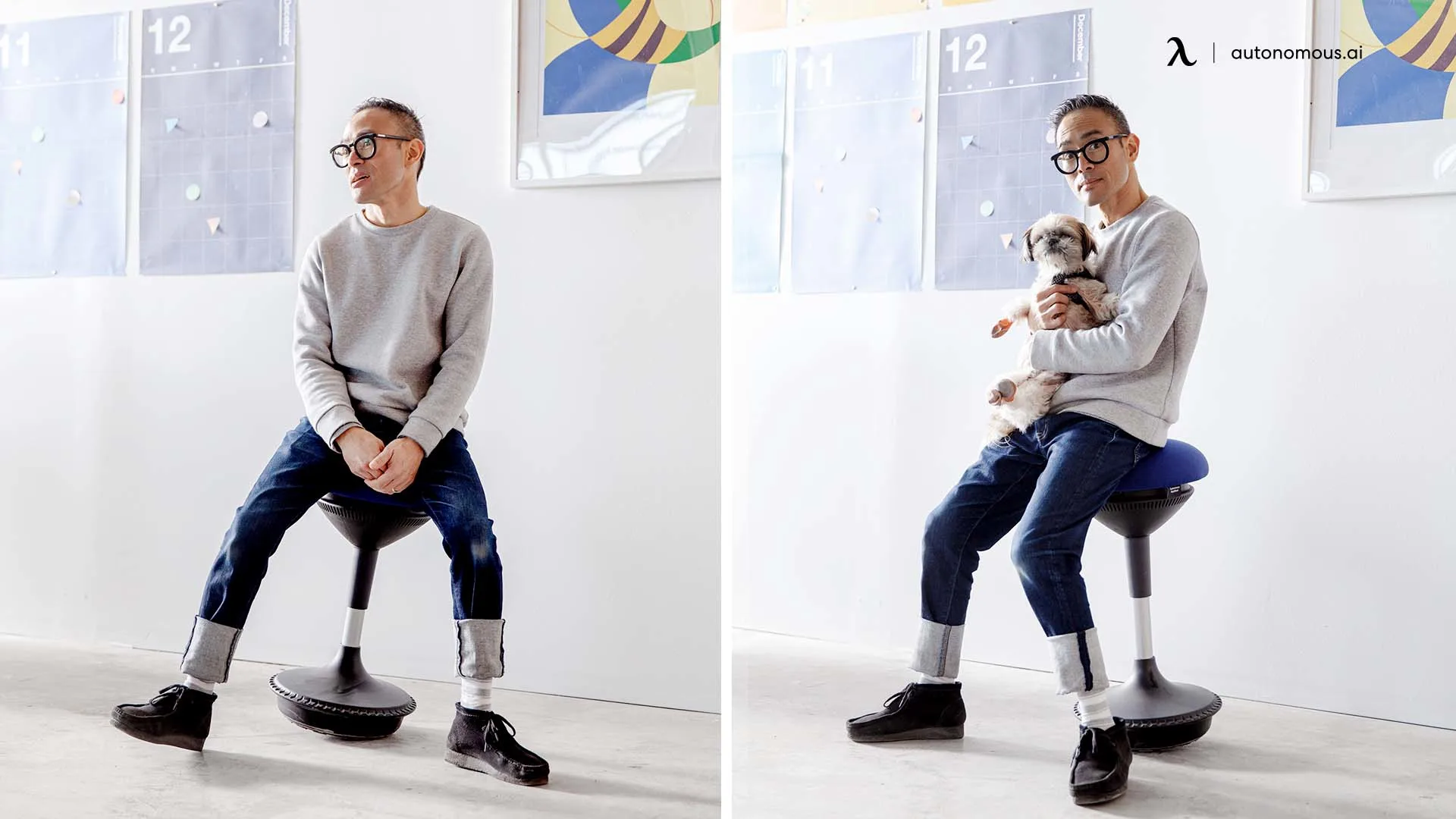
How to Adjust Your Ergonomic Saddle Office Chair for Maximum Comfort?
Getting the setup right matters more with saddle seating than with traditional chairs. Here's a quick sequence to dial in comfort.
- Start with height to set the hip angle, not the desk height
Your hips should sit slightly higher than your knees, with thighs angling gently downward toward the floor. This position keeps your pelvis from rolling backward, which is what causes the "tuck and slump" pattern in most office chairs.
How to check: Sit with feet flat on the floor. If your knees are level with or higher than your hips, raise the seat. If you feel like you're sliding off the front edge, lower it one notch at a time until you feel stable.
- Use the “foot contact rule” to prevent inner-thigh pressure
Inner-thigh pressure is one of the most common complaints with saddle seats — and it's usually a setup issue, not a flaw in the chair. Your legs act as stabilizers, so when your feet aren't firmly planted, your thighs absorb more load than they should.
How to fix: If your feet feel light on the floor or you notice pressure near the front edges of the seat, either lower the seat height slightly or add a footrest. This is especially important for taller desk height or when using an ergonomic saddle stool with a standing desk.
- Adjust tilt conservatively
If your chair has a tilt function, start in the neutral position and make small changes from there. The goal is to feel gently supported in an upright posture — not braced or forced.
Signs of too much forward tilt: Sliding forward, tight hips, pressure concentrated at the front of the seat.
Signs of too little tilt: Rounding in the lower back, feeling like you're collapsing into the seat.
For split-seat models, be especially conservative — the divided design already changes how pressure distributes, and aggressive tilt can make sliding worse.
- Position the chair for elbows first, then fine-tune the seat
A common mistake is adjusting the saddle height to fix discomfort that's actually caused by desk positioning. Once your seat height is set, roll in close enough that your elbows can rest near your sides while typing. If you're reaching forward to your keyboard, your spine will pull into a forward slump — undoing the benefits of the saddle position.
- For standing desks, treat a saddle stool as a “mid-height station”
For sit-stand routines, keep your ergonomic saddle stool at a mid-height perch rather than dropping it to normal chair height. Your torso should stay tall and your hips should stay open. If the seat is too low relative to the desk, you'll shrug your shoulders and reach upward; too high and you'll lose stable foot contact.
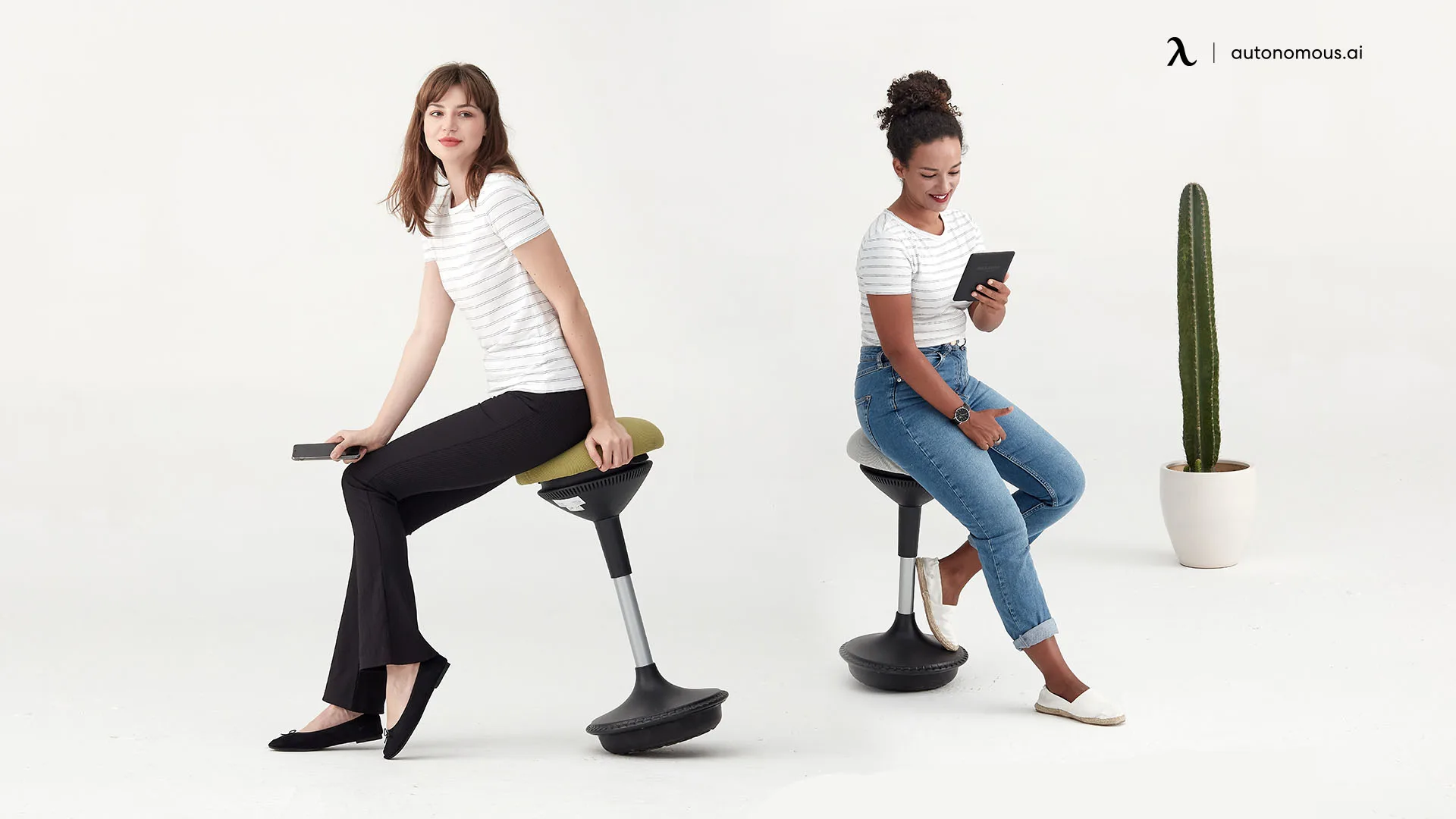
FAQs
What is the best ergonomic saddle chair for desk work?
Look for a stable base, enough height range for your desk, and a seat shape that matches your build. If you sit for long blocks, prioritize a model that feels supportive without forcing pressure on the inner thighs.
Is an ergonomic saddle chair worth it compared to a normal office chair?
An ergonomic saddle chair can be worth it if you slouch in soft chairs or want a more active sitting posture. A traditional ergonomic office chair is often better if you need relaxed, all-day back support.
Are saddle chairs good for ergonomics?
Yes, an ergonomic saddle chair can encourage a more open hip angle and a more upright sitting position than many flat office chairs. It works best when height is set correctly and you alternate positions instead of staying static for hours.
Are saddle chairs good for your back?
They can be, especially if your usual chair leads to slouching or a tucked pelvis. A saddle seat often helps you maintain a more neutral pelvis position, which can reduce low-back strain for some users.
Are saddle chairs good for posture?
Often, yes. Because the seat shape changes how your hips sit, many people find it easier to stay upright with less rounding in the lower back compared with a soft, flat seat.
Is a saddle chair good for back pain?
Sometimes. If your back pain is linked to prolonged slouched sitting, an ergonomic posture saddle chair may help by reducing collapse in the lower back, but it won’t fix pain caused by other issues or poor workstation setup.
Is a saddle chair good for sciatica?
It depends. Some people find a saddle seat reduces pressure from prolonged sitting, while others feel irritation if the seat edges or height create hip tension; starting with short sessions and correct height/foot support matters.
Can you sit in a saddle chair all day?
Not everyone can sit comfortably, especially at first. Many users do better using an ergonomic saddle chair or ergonomic saddle stool in blocks and rotating with standing or a standard chair.
Is an ergonomic saddle stool with backrest actually supportive?
It usually provides light support, not the same lumbar support as a full ergonomic saddle chair with backrest. It’s best for task work where you want occasional contact rather than leaning back for long periods.
What are the disadvantages of a saddle chair?
Common downsides include an adjustment period, possible inner-thigh pressure if height is wrong, and limited relaxation compared with cushioned task chairs. Models without back support may also fatigue you faster during long, uninterrupted sitting.
How do you sit correctly in an ergonomic saddle chair?
Sit back so your weight is centered, keep your feet planted, and aim for hips slightly higher than knees. If you feel pressure at the seat edges, adjust height down slightly or add a footrest so your legs can share the load.
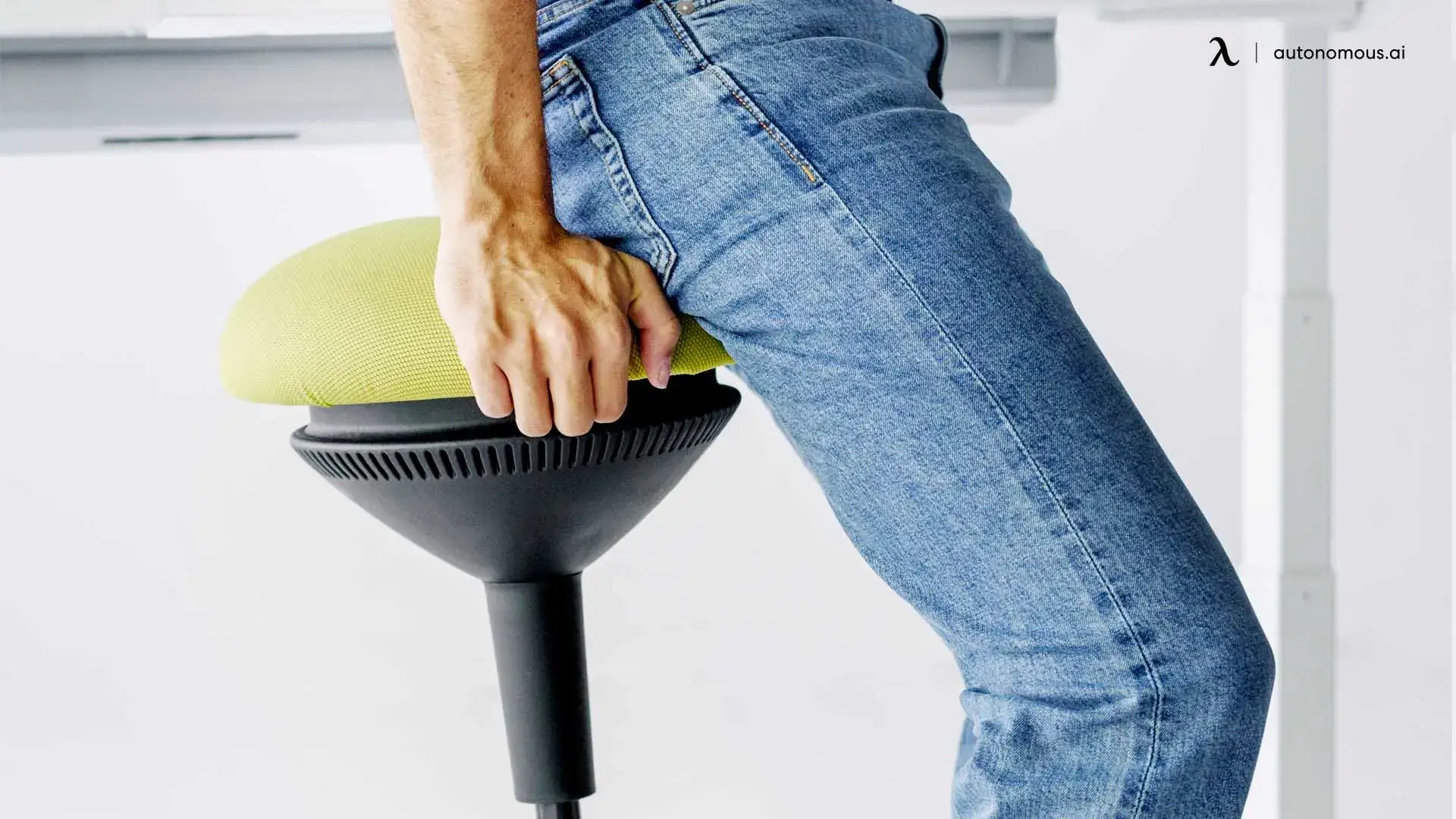
Wrap Up
An ergonomic saddle chair can be a strong fit if your main goal is to sit more upright, keep hips more open, and reduce the tendency to slump during desk work. It's one of several office chair alternatives worth exploring if traditional seating hasn't worked for you. Chair-style models generally suit longer, more stable sessions, while an ergonomic saddle stool is better for active perching and quick transitions—especially in sit-stand routines.
To choose the right option, match the seat style to how you actually work. If you sit in long blocks, prioritize adjustability and consider an ergonomic saddle chair with backrest. If you alternate positions often, a simpler ergonomic saddle stool (or an ergonomic saddle stool with backrest for light support) can deliver posture variety without adding complexity. Saddle stools without backrests fall into the broader category of backless office chair designs, which suit users who prefer core engagement over passive lumbar support.
The most important factor is setup. Even the best ergonomic saddle chair won’t feel right if height and foot support are off—so dial in fit first, then build up usage gradually.
.svg)

